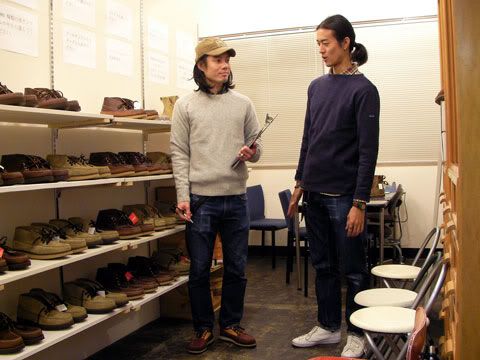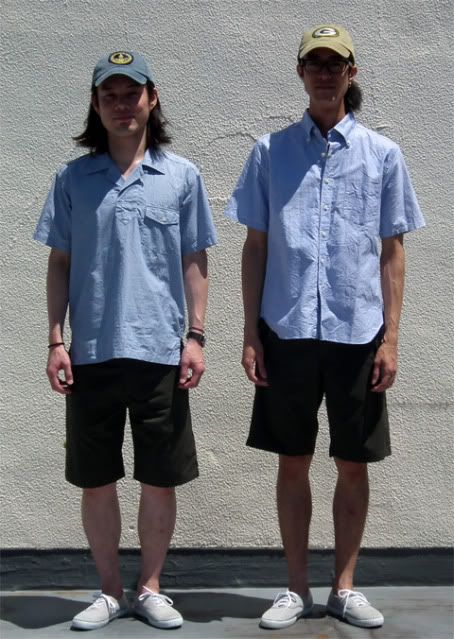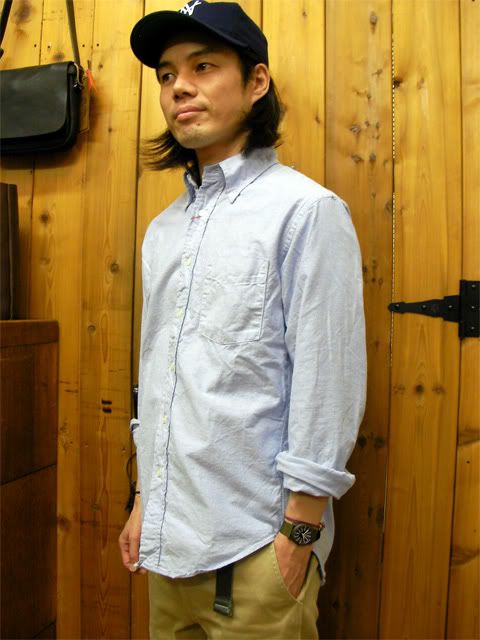
(take note of Russel Moccasin collection for sale - extensive)
The following interview with Zabou is awkward due to a language barrier. However, these are a group of guys who enjoy what they do and know that dressing yourself isn’t serious business. If putting clothes on in the morning is serious business for you can I suggest a subscription to Model Railroader? Perhaps you will enjoy recreating a personal expression of history in your basement rather than a personal expression of history in public.
If you take anything away from this I would hope it’s their concept of Ame-cazi style. They don’t make it hard for themselves, really.

Q:
Online blog archives dates you guys to 2006, but when did Zabou officially open?
A:
June, 1997
Q:
Occasionally, you guys will post pictures of the people that influence a specific look.
Who are people that influence the Zabou look as a whole?
A:
This is a very good question. We could say that this is what we Japanese do best, which is to research and understand various "originals" from around the world, and adapt/customize them into our own ways. These "originals" range from the characters from the novels written by Hemingway, Alain Delon, to the hippies we meet at places we visit.
Q:
How has the Zabou style evolved?
A:
Zabou style is the style in which we produce relying only on our own perspectives.Judging by our fashion senses and perspectives, we choose what is cool and fashionable,and try to make it a standard. Our definition of "cool" is influenced not only by the latest trends, but also by the things that are considered universal, and are not influenced by trends. One of the objectives of the ZAbou style is to look "normal" no matter who looks at it, and to be able to adaptto various occasions. The Zabou style is based fundamentally on two main facts: we love people, and we love clothes. The fashion industry is a quickly evolving industry, with new trends and styles made every season. But even if the trends change, we will keep relying on our own perspectives.

Q:
How much are you guys influenced by American style?
A:
About 50%. As you Americans obviously know, the US has many elements in which we are inspired by. For example, the cultural difference within the country (East coast and West coast), the climate, and race are all very influential for us. The other half is from the culture and history of Europe and other regions.
Q:
Zabou is influenced by sports. What are the sorts that you guys participate in yourselves?
A:
The sports we often enjoy are jogging( I don't know if you call it a sport), biking, trekking, and snowboarding. There are many things in which we are inspired by sports. We believe that the satisfaction we get from being dressed in comfortable and well-balanced clothes is something that everyone seeks for, and we try to persue that ideology in various ways. For instance,
creating things by using newly developed fabric or materials, promoting hybrid styles produced by combining low-tech and hi-tec styles, etc. In addition, (internet) surfing is also essential for creating new styles.

Q:
If you were to hike across Japan, what are the 5 things that you would bring with you?
A:
First of all, we enjoy hiking as a tool for creating the Zabou style. We try on various clothes and gather various things, and repeat that over and over before finally deciding what we need and don't need to take with us. The five things that we would take with us to hiking, are bottled water, rice-balls( so that we don't starve to death), a cellphone, a camera, and last but not least, friends. Water is obviously for satisfying our thirst, cellphones are for gathering various information, and a camera is needed for taking pictures to post on our blog, and friends are essential for sharing those precious moments.
Q:
What is new for Zabou in the future?
A:
Our motto is "creating real gentlemen", and this is what we have been trying to accomplish ever since we began. Time goes by, but there are things that don't change, and those are the things we find important. Like how liquid changes its form depending on the type of cup it fills, we, too, have to transform ourselves and open our minds to new things, even if we have to leave behind the things we are accustomed to. That is what we do, and will keep doing in the future. To us, things like increasing the number of stores and making inroads into foreign markets, are not what we consider as our goal, but just a process for achieving our goal.
Our superiors have interpreted the casual fashion styles of the US into their own ways, and have created the style now known as "Ame-cazi" (short for American casual). They may have been wrongfully interpreted, or simply a general Japanese interpretation of America, but what is important, is finding our own individual ways under those circumstances.
Q:
Who does the Zabou team consist of?
A:
Zabou consists of 5 unique individuals.
We all love clothes, and how they characterize our individualities greatly. One of our staff members attracts various customers and predicts their tastes with his accurate sensitivity, while another staff member, having sufficient knowledge on behavioral psychology, is an expert on marketing. There are also staff members who dedicate their time researching fashion and layouts, and others who use their technological pc skills to manage our website and online store. As you can see, Zabou consists of individuals with totally different personalities.

Q:
As it becomes hotter (interview was begun in July; I’m lazy), what are the fabrics that you guys look for to help deal with temperature?
A:
In terms of fabrics that have been around since the old times, we would have to say cotton and linen. We also recommend fabrics like seersuckers and chambray for the summer. On the other hand, in terms of relatively new fabrics developed from the latest technology, cool-max and outlast are suited for hot weather. After all, whatever fabric that makes people both feel
and look nice and cool in the summer is considered appropriate.
Q:
What do you guys consider staples in a Ame-cazi wardrobe? What sorts of things are most useful in your
dress?
A:
Button-down shirts, jeans, khaki pants, and military pants are items that always come in handy for Ame-cazi fashion. We also consider canvas sneakers and suede oxford shoes standard and essential items. In our opinion, outfits have to be comfortable and simple, with basic colors. We try to carry practical items that use natural fabrics, and fabrics that show different expressions
as you wear them. We promote *hybrid and *versatile styles that combine traditional, military, work, outdoor, and sports styles.
